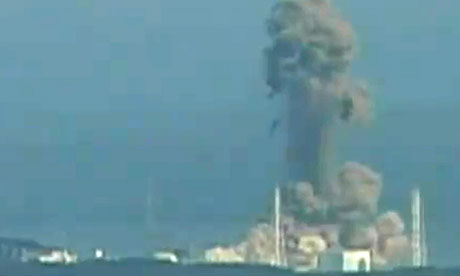On March 30, 2012 I wrote a blog entry entitled “Review of Fukushima Daiichi Nuclear Disaster”. In
this entry, I briefly discussed the necessity of providing adequate venting to
prevent the escape of radioactive waste to the outside in the event of loss of
power and a resulting explosion. Here is
what I wrote:
“Venting
channels to help relieve the high pressures resulting from any explosion inside
the reactor are readily provided in a domed containment structure. These vents
are typically filled with boron-based sand or aggregate, and activated carbon.
This sand, aggregate and activated carbon remove radioactive material from
explosive gasses as they pass through the venting channel, before they vent to
the outside atmosphere.”
In
response to this entry, some anonymous source posted the following remark on
May 2, 2012:
“Containment is supposed to be virtually leak-tight under all
Design Basis conditions. Venting Channels defeat this purpose.”
I replied on May 2, 2012:
“It is impossible to contain a supersonic
explosion without venting, or else the containment structure becomes a
"bomb". See this discussion by Arnie Gunderson of Fairewinds.
Evidence seems to indicate "inadvertent criticality" as cause of
explosion. In order to begin to control the effects of such an explosion
venting is required. http://www.youtube.com/watch?v=vs53iOn2K2w
The same anonymous source then replied once
more, also on May 2, 2012:
“An explosion is beyond Design Basis except
for Steam Generator Faults and LOCAs. These are supposed to be complely
contained within containment. Any explosion such as "inadvertent
re-criticality" is not containable without loss of containment integrity.”
At this point, I realized that due to the
language used, the defensive posturing, and the inability to admit a design
flaw in an inherently flawed design; that I was most likely communicating with
an engineer or Public Relations employee from General Electric (GE). The nuclear reactors involved in the
Fukushima Daiich disaster are GE Mark I reactors. There are currently 31 reactors very similar
to those at Fukushima Daiichi in the US.
In an effort to be clear, to emphasize a
solution, and, furthermore, in an attempt not to antagonize or further alienate
this anonymous commenter, I offered the following, final remark in our exchange
(also on May 2, 2012):
“The containment structure is not adequate
to contain an explosion without venting. (I think we are saying the same
thing?) As proven by experience, explosions happen at nuclear reactors. The
containment structure should be designed to withstand an explosion, this
necessitates inclusion of proper venting. The existing structures at Fukushima
were improperly designed and built. They need to be fixed, they need better
containment (with venting) since explosions can and do happen.”
My hapless anonymous commenter did not
respond.
Today, March 19, 2013, The US Nuclear
Regulatory Commission (USNRC) posted an entry on their blog, entitled “NRC Commission Approves More Post-Fukushima Upgrades to Nuclear Plants.” In this blog entry, the NRC demands
strengthened venting at the 31 nuclear reactors in the US which are similar to
the GE reactors involved in the disaster at Fukushima Daiichi.
Quoting from today’s USNRC blog entry
(3/18/13):
“The venting systems at Fukushima played a role in their nuclear
crisis, and the NRC issued an Order to the 31 plants with similar designs to
take action. The plants either had to install vents or improve their existing
venting system. The goal was to make sure the vents can operate during the
early phases of an accident, even if the plant lost all power for an extended
time.
In their latest decision, the NRC Commission votes to further
strengthen these vents. The NRC staff has 60 days to finalize an Order for
these enhancements. Generally speaking, these additional requirements mean the
vents could handle the pressures, temperatures and radiation levels from a
damaged reactor, and that plant personnel could operate the vents under these
conditions.
As part of the same decision, the Commissioners directed the
staff to begin a formal rulemaking on filtering methods that would prevent
radioactive material from escaping containment in an accident, either through
new filter systems or a combination of existing systems. The staff will develop
the technical analysis, a proposed rule and then a final rule. Throughout this
process, the public and various stakeholders will have opportunities to submit
comments and attend meetings to ask questions. And there will be many future
posts about the progress!”
To my anonymous commenter: I told you so!
Luckily, there has not been a nuclear disaster
in the US since the March 11, 2011 tsunami disaster in Japan. Hopefully there will not be a disaster before
proper venting is provided to the 31 nuclear reactors in the US which are inherently
flawed and pose a significant risk in the meantime. If any nuclear reactor operators are seeking
an effective, affordable solution to this engineering challenge, I urge you to
contact me. I was right when I posted on
March 30, 2012; I am right now.




No comments:
Post a Comment